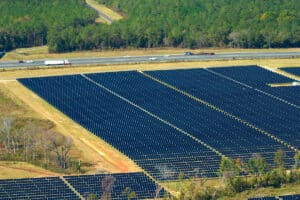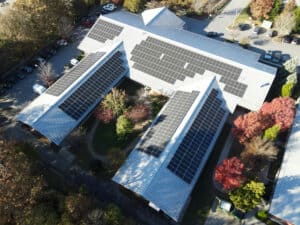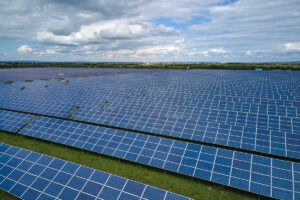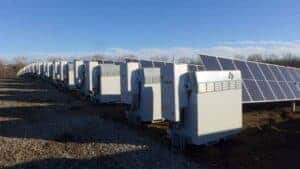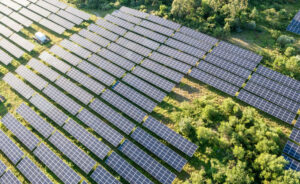What is ADMS?
ADMS stands for Advanced Demand Management System. Our demand management system is different than most other demand management, or peak (load) shaving software. EnergyLink installs proactive building automation software to improve building comfort while maximizing energy savings.
The advanced demand management system portion of our services is used to help our customers track and monitor their buildings energy usage and savings once our process is complete.
With our advanced demand management systems we are able to connect all of your building’s energy assets with the automation controller we develop specifically for your building. This uses a custom algorithm that is able to modify how and when your facility uses power.
Our demand management system’s primary objectives are to generate an on-site renewable energy and utilize a building automation system (BAS) to automate the facilities energy systems (HVAC, lights, solar, boilers, etc.). These two goals then contribute to smarter energy usage by your building and a lowered utility cost that make for one of the best energy investments a commercial building owner can make.
What energy assets can be used with an advanced demand management system?
Energy assets refer to the individual systems used by your building. We analyze your current systems and determine how we can integrate them into our automation system, and give suggestions on which would be beneficial to install. This is different from most contractors, who are simply pushing products.
One of the key elements in our advanced demand management systems is solar energy. We find rebates and tax incentives your city and utility provider offers and apply them to determine the most cost-effective way to install a solar energy system on your building.
Other energy assets that can be used in our system include:
- lighting
- wind
- radiant energy controls
- daylight harvesting
- thermal storage
- HVAC zoning
- refrigeration
- boiler systems
- batteries
- HVAC
How does the EnergyLink ADMS process work?
A simplified breakdown of our innovative process is:
- Analyze your historic utility bills and facilities operations
- Determine most cost-effective improvements, and also take into consideration customers needs (i.e. high utility costs, outdated HVAC systems, etc.)
- Begin engineering the ADMS to determine what is needed to meet the goals of the algorithm
- Begin our engineering, procurement, and construction (EPC) services
Our process is custom tailored to each client. It includes constant analysis and evaluation to determine the most cost-effective approach, accounting for customer needs, and retaining maximum comfort for customers and/or employees.
Some frequently asked questions and personal concerns of business owners of business owners include:
How does project development begin?
Once we have agreed to terms and move forward with formal engineering, our team of engineers will begin to perform full analysis on the facilities operations.
This includes gathering items such as an HVAC matrix, official lighting counts, existing mechanical system details, building structure, and more.
The development stage typically takes 1-2 months, but the exact time frame depends on the size and complexity of the facility.
How long is the construction period?
After formal engineering, we will begin to our construction phase of our EPC.
During the first 2-3 weeks we begin ordering the appropriate materials and requesting building permits needed.
The next 2-3 weeks will be used for installing the system on your facility. We will rack and wire all of the panels, install building controls, and make any necessary replacements to lighting and mechanical systems.
Finally, we spend around 2 weeks working with your utility provider so we can interconnect your system to begin generating power for your facility.
Is ongoing maintenance included after installation is complete?
EnergyLink includes a 5 year labor warranty, and the improvements we install typically provide a manufacturers warranty. For items such as solar that can be up to 25 years. Our customers can be assured their systems with perform properly for the life of the systems.
In addition, we offer an O&M (Operations & Maintenance) package for an annual fee. We will provide annual maintenance and check-ups to ensure the equipment is operating properly. Generally we do not recommend this, but rather reiterate for the building owner to periodically check up on the equipment to ensure the systems are cleaned off and operating properly.
How do we integrate the system into your building?
Integrating Solar + ADMS is simple.
We work around any fixtures within your building for wiring purposes. The solar array connects into your incoming electric panel for your facility. Our on-site project managers monitor each portion of the installation, and make sure each improvement is safely and properly installed.
What are building controls?
All of our advanced demand management system include building controls. These ADMS building controls allow our engineers to install the demand management algorithms that significantly reduce your facility’s demand. These controls can also track your mechanical systems, and detect faulty equipment before they completely fail.
How do I know my energy management system is working?
Aside from your pockets growing with cash and seeing a significant reduction on your energy bill, your solar array will be tracked through your own web portal that we develop for all of our customers. This portal will allow you to see real-time and historical production from your solar array – making it easier to track and monitor your building’s energy use and reduction.
How easy is the entire system to use?
The best part about our energy system solutions is they work for you.
While we recommend you check in on your system periodically, solar + ADMS is set up to run autonomously. Not only will it save your businesses hard earned money, but will improve the comfort.
Your mechanical systems will no longer be fighting each other to maintain proper temperature, but instead they will work together to properly heat and cool the facility.
